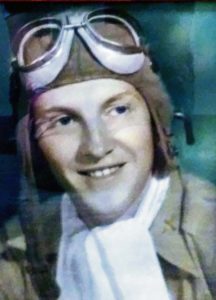
After nine years of research, Dr. Stephen Johnson picks up a small, worn artifact among his possessions and polishes the rough surface with his thumb. The piece originated from a downed World War II A-36A Apache aircraft nicknamed “Stelloola,” after its pilot’s little sister. The remnant reminds Johnson of the rigorous search to help Estelle “Stelloola” Sherry lay her brother, Army 1st Lt. Herschel H. Mattes, to rest after 75 years.
Johnson, a Defense POW/MIA Accounting Agency historian, started working cases associated with WWII air losses over Italy in 2010.
It was 1944 when Mattes’s A-36A Apache aircraft went down near Lake Bracciano, Italy. A 22-year old Mattes had left his home and fiancée to join the 525th Fighter-Bomber Squadron, 86th Fighter-Bomber Group, a unit that would eventually become the 86th Operations Group at Ramstein Air Base.
During World War II, the 525 FBS primarily provided close air support of ground forces in Europe, with the 86th FBG moving forward to bases in Sicily, Italy; Corsica, France; and Germany as the battle line changed.
“Hershey,” Sherry said, was “always smiling and handsome.”
Mattes was six years her senior and the only male in her childhood home. He taught Sherry everything from throwing a ball to riding a bike and traveling around Pittsburgh in streetcars.
According to historical squadron documents, Mattes’s comrades reported seeing his plane crash on March 6 during an armed reconnaissance mission. He was struck by small arms or machine gun fire while conducting a dive maneuver.
At the time, friendly forces could not immediately recover Mattes from the enemy-occupied territory. In October 1944, the owner of an Italian villa reached out to the U.S. Forces in Rome to report a U.S. Soldier was buried on the property. A gravesite had been erected on villa grounds with a German marker citing “Here rest [sic] one American Fighter-pilot, shot down on 6 March 1944.” The U.S., still in the midst of fighting World War II, did not respond until after a second attempt to make contact in September 1947. This attempt proved successful, and the U.S. Army sent two members of the American Graves Registration Service to collect the remains.
The remains, identified only as an unknown U.S. Soldier, were relocated to a grave at the Sicily-Rome American Cemetery and Memorial in Nettuno, Italy, as Unknown X-977.
In 1943 the Army adopted the use of Missing Air Crew Reports to help consolidate data and determine the fate of missing personnel. Unfortunately, there was not a MACR filed for Mattes’s crash, which made it difficult to narrow down his final whereabouts.
Johnson relied on historical data, circumstantial evidence, and witness statements, ultimately feeling more and more confident that X-977 could be Mattes.
To test his hypothesis, Johnson visited the Italian villa where the remains were initially buried and consulted with Dr. Vincenzo Lucherini, an Italian independent researcher. In 2015, after recognizing the strong historical case that the remains could be matched to Mattes, the DPAA moved forward and sought Department of Defense permission to disinter X-977.
The remains were exhumed and sent to a DPAA forensic laboratory at Offutt Air Force Base, Neb. Samples of skeletal remains were sent to the Armed Forces DNA Identification Laboratory in Dover, Del. Laboratory experts ran into challenges getting a complete, reproducible sequence of DNA since the body had been treated with preservatives prior to burial at the Sicily-Rome American Cemetery. However, persistence paid off and in July 2019, experts positively matched the remains to Mattes.
After a formal next-of-kin notification by U.S. Army Casualty officials, Johnson reached out to Mattes’ sister to celebrate. The two had been in regular contact during family updates from Johnson’s team.
The family held a funeral in Avon, Conn. for Mattes on Sept. 23, marking the end of a long chapter. Sherry said she never thought she’d be able to bring her brother home to bury him, and finally being able to do so brought her peace.
DPAA’s mission is to provide the fullest possible accounting for personnel listed as POW or MIA from past conflicts. Johnson says the worldwide organization is truly a team effort with many experts contributing to the more than 200 identifications each year.
To find out more about DPAA and their mission, visit https://www.dpaa.mil/.


